An interview with Vytautas Landsbergis
The exhibition Fluxus East. Fluxus Networks in Central Eastern Europe was presented in Berlin from September to November 2007. Subsequently it travelled to Vilnius (2007), Kraków (2008), Budapest (2008) and Tallinn (2008). For the first time Fluxus art was collected and exhibited to show the history of this movement in the former Eastern Bloc. An extensive catalogue of this unique exhibition was produced, containing exhaustive documentation plus the interviews with the members of the Fluxus movement. The interview with Vytautas Landsbergis (musicologist and former president of Lithuania), who introduced Fluxus into Lithuania, was conducted by the curator of the exhibition, Petra Stegmann. The interview is reprinted with the kind permission of the author.
Petra Stegmann (PS): When and how did your contact to Jurgis Mačiūnas (George Maciunas) come about in the 1960s?
Vytautas Landsbergis (VL): Jurgis was my friend in primary school. We were boys and we enjoyed playing games at home, because he lived very near to my family home in Kaunas. We attended the same school, the same second class in 1939, just before the war, a year before the occupation of Lithuania by the Soviet Union. We were in school together only one year, but we continued to meet each other, to play, inventing various games, as boys usually do. I remember him having an impressive electric train. Maybe I asked my parents, and received it too, later. Maybe. A little later, those were the years of the German occupation of Lithuania, he lived with his family in another place, more distant, but I could go and visit him, since I was a bit older now. So we used to meet again. And it was friendship and common activities, common talks, fantasies and games for our age group (we were about 10 or 11).
The end of the war and the second occupation of Lithuania by the Soviets, cut off our direct contact, and I did not have any information about him and his parents up to 1962, when one Lithuanian American, or American Lithuanian, Almus Šalčius, visited Vilnius in summer 1962. He had his own interests in initiating cultural contacts, and he wanted to make some film about the Lithuanian artist/painter Čiurlionis. I was also studying his art and playing the music of Čiurlionis, so Šalčius contacted me, and we made a project for his film. I wrote a script and a programme for it.
PS: What were the subjects of your discussions with Almus Šalčius?
VL: We talked about different things, and about the artistic life in New York, about avant-gardes. And when he mentioned Jurgis Mačiūnas, I caught the name of the boy known to me from times 20 years before, and I asked him when he was back in New York, to ask Jurgis whether he was the same person that started school together with me. And very soon I received a letter from Jurgis, or maybe I received his address – so, anyway, the letters started to go across the Atlantic, and so we exchanged a set of letters. My first interest was to get in contact with somebody in modern arts in New York, who was interested in Čiurlionis as a modern, symbolist, fantastic and abstract painter, a very early modernist in Lithuania and in the world, in order to promote his art; to get some publicity about Čiurlionis, and about Lithuania in the United States in the same way. And I asked Jurgis about a possible cooperation. But he responded that he was not interested in that sort of art. But he also told me what he was interested in, what he was up to, and it appeared interesting. He wrote that it was art for all people, not just for the educated – very democratic. His letters were very instructive to me, because he also sent packages of materials.


George Maciunas: letter to Vytautas Landsbergis, February 1963, Vilnius, Collection Vytautas Landsbergis. Translation below.
Greetings, Vytas!
I was very happy to receive your letter. I am interested in locating my old friends. Besides, I am interested in making contacts with cultural and political activists in Lithuania and the Soviet Union. My interests in seeking such contacts are motivated by a Fluxus desire to clarify the communist principles re. the new art. This new art is:
1. Concrete and realistic, because it doesn’t lean towards artificiality or illusionism or intellectualism or abstractism—neither in content, nor form, nor style.
2. Folk Art—because it’s not made for specialists, critics, artists and other intellectuals. Such art can be created, understood and performed by all—by the educated and non-educated. It’s made for all.
3. Socialist—because such art would eliminate forever the profession of the artist and would prescribe to former artists more socially useful jobs.
In order not to repeat, I am enclosing with this letter a short article which attempts to explain the principles of that new art. (I will send you other articles separately, right now I am in a hospital and do not have the articles with me.) Also I am enclosing our Manifesto. Separately I am sending a new copies of FLUXUS NO.1 (so far there was only one number published). I am also sending some magnetic tapes with music (from our concerts), programmes of our concerts, photographs, posters, etc.—in short, a package with miscellaneous paper scraps.
I am not sending you the book on dodecaphonism. I am not sending it and I am not advising it to you, because dodecaphonism is decadent and outdated, behind the times. Like abstract art, it has no social meaning, it’s understood only by musicans and mathematicans, and, besides, it’s understandable only after the scores have been fully studied. But I will send you several John Cage compositions (scores and tapes) which, in my opinion, are more meaningful to our times and to the evolution of the new art.
Forgive me the mistakes of my Lithuanian. Even in Lithuania, in school I always got the worst marks for the Lithuanian grammar, I didn’t use any accents, etc. And now, I have no occasions to write in Lithuanian at all, I am writing in English, and I have no contacts at all with the Lithuanian immigrant community, I have no interest in their decadent chauvinism and reactionary bourgeois thinking. Šalčius is one rare exception even if he’s still too immersed in narrow Lithuanian, and not anational, supranational questions.
I would very much like to visit the Soviet Union and Lithuania (maybe in Summer 1964). Especially I would like very much to organize in Lithuania—and other places—a series of concerts (new music and „theater” or „eye-kineticmusic“). Such concerts I could present with local talent. You could help me, perhaps, with the preparations and presentations of such concerts? Do you have connections with offices that could provide me with an auditorium, and help prepare the posters, etc. I would come on my own expense, and I wouldn’t charge anything for the concerts. It’s possible that I would come with two composers—one from Japan, another from USA. We (that is, Fluxus activists) we have already organised five festivals. We gave 14 concerts in Wiesbaden, in London one, in Copenhagen seven, in Paris eight, and last week in Dusseldorf two concerts at the Art Academy. This spring we are making plans to travel to Poland; in the fall—to Florence, Milan and New York; in Winter perhaps to Japan. So that it would be the best for us to come to the Soviet Union via Siberia (we could give concerts there too).
Write to me about the possibilities of giving such concerts in Lithuania. Fluxus No.1 contains many examples of Fluxus music, art and magnetic tapes, so it will give you a good idea about the programmes of such concerts. I would like to know something about the state of new music in Lithuania today. Could you send me something?
Best regards,
Jurgis Mačiūnas
I have a big favour to ask you. Could you find out where I could get—buy or borrow—photo copies of LEF magazine which was edited by Mayakovski? We would like to publish a facsimile in our Eastern European issue of FLUXUS. Maybe you have some friends in Moscow or Leningrad who could help with it? Try.
Another request. I have a friend who wants very badly to study in the Soviet Union. Could you find out procedures how to go about it? He is a participant of FLUXUS and one of the editors—Henry Flynt—politically trustworthy.
PS: What kind of material did Mačiūnas send to you?
VL: Once he sent me his attack on Stockhausen. Because Stockhausen said something unfortunate about jazz – and Jurgis loved jazz, like everything free in the arts – as well as ancient music. He sent me a collection of his own already used LPs, and it was informative for me, as a historical musicologist. He sent me Monteverdi (Vespro della Beata Vergina), Scarlatti, Bach (St. Matthew’s Passion), very good performances, which I used immediately in the lectures for my students. He also sent jazz, which I used in my lectures for broad audiences – Coltrane and free jazz, Coleman, for example. And then of course he sent me many tapes of Fluxus performances (fig. 2), and rolled papers with instructions and references about the Wiesbaden festival and others. And also boxes which Jurgis designed. And small cards of instructive ideas.
He was very enthusiastic because of our renewed friendship and, maybe, having a person in Lithuania again for contacts and to promote his ideas. When he asked me in one of his letters about his chances of implementing a project to go traveling across the Soviet Union with presentations of Fluxus art, or non-art, as he called it, I was doubtful about such a possibility, because of the very conservative and limited mentality of the Soviet authorities on art, and their controlling of all art events. Then I sent him back a letter about my doubtfulness, and about why and how such art and performances, like the Piano Activities, for example, should be treated in the Soviet cultural region. And as I of course did not know enough about the essence of the issue, and maybe I underlined this tremendous ignorance of my own but also of those around me, he responded in a very interesting way, in a long letter, explaining where my fault was, what I had misunderstood, and he explained the ideology and what this movement is all about. So that was the beginning of me becoming attracted too. I realised that I could not do anything with it, but it was interesting for me personally.
PS: How did you use the material Mačiūnas sent to you?
|
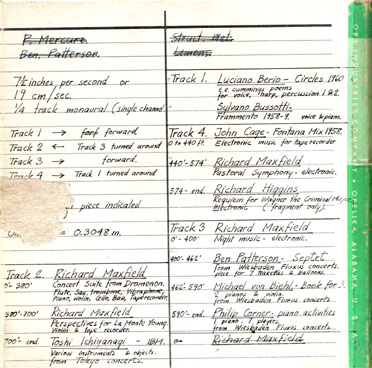
One of the audiotapes sent to Vytautas Landsbergis from
George Maciunas with recordings of pieces by Richard Maxfield,
Toshi Ichiyanagi, Luciano Berio, Sylvano Bussotti, John Cage,
Ben Patterson, Michael von Biehl and Philip Corner,
Vilnius, Collection Vytautas Landsbergis
|
VL: In turn, I used this material in my lectures; my public lectures about modern music all over the world, including those very radical, extreme Western links and trends. And they were examples that I presented during my lectures for the public – not in the conservatory, where I was a teacher, and later a professor in the history of music. But I spoke about modern music; there were always people and organizations inviting me to present what was going on in the world of modern music.
PS: And these lectures also took place in the sixties?
VL: Yes, in the 1960s, maybe also in the 70s. And very often I used a tape sent by Mačiūnas. Philip Corner was with his Piano Activities one of the authors. What one could hear on the tape was indeed impressive. Very unexpected, unusual, but I used to tell the audience about some of my perception, or possible perception of it. I told them how broad the content may be, and that each performance is not only for the performers, it is also for the audience and their perception is part of this creative event.
PS: And concerning these activities in the 1960s – was there any press reaction, anybody writing about what you did, or any problematic political reactions?
VL: No, there were only comments after the lectures, and questions, responses.
PS: And the reaction – was it more positive or more sceptical?
VL: No, positive. Of course people could be surprised or not appreciative, but that is normal.
PS: How was the response from the students, did they find it interesting?
|
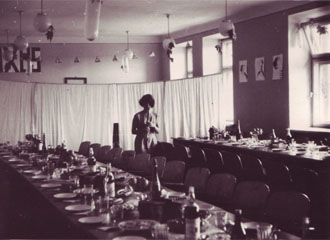
Fluxus concert at Vilnius Pedagogical Institute, spring 1966
photo: Vytautas Landsbergis
|
VL: Of course, and not only students, but also older artists and actors. In the House of Actors, I remember a very large audience. I gave a lecture at the Institute of Fine Arts, also in smaller groups, and I was able to use my personal direct impressions, experience and information brought from the Warsaw Autumn, which I attended for the first time in 1963 – and this coincided with my contact with Fluxus. In Warsaw, there were people whom I found in the programmes of Fluxus, like Frederic Rzewski. Warsaw was really some distance away, because in the Soviet system you were limited in your travel, even going to Warsaw from Vilnius. However, having a fresh impression, having direct impressions and materials, records and scores – a few scores – I was already a person who knew a little more than the rest. As for Fluxus, I was probably the only one in Lithuania who knew anything, and it was very interesting and unique, and I liked to present it, describing ideas and presenting recordings, like that recording of Piano Activities, was very impressive. Not as terrible as I had thought in advance. It was inspiring, it brought more and more ideas about the situation of civilization and the culture it was talking about. And that was a period of growing knowledge for me, and my contacts with Jurgis increased. He used to send me more and more instructive and educative materials – and materials for performance, of course. I could not use it for performances, but I could imagine, I could tell the audiences, and there was one more event when I used those ideas practically. I was a teacher in Vilnius’ Pedagogical Institute, and it was a joyful party for the course or group of students graduating.
PS: In 1966?
|
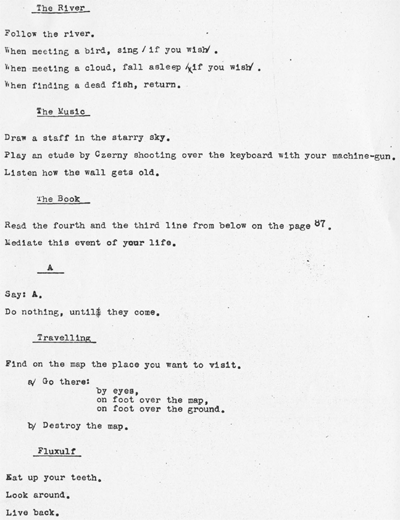
Vytautas Landsbergis: Six Games, sent to George Maciunas,
San Diego/California, Mandeville Special Collections Library, USCD,
Ken Friedman Collection
|
VL: Yes, and some programme was prepared, under my supervision, where also my ideas were implemented. I used those Fluxus ideas. And it became a unique Fluxus event in Vilnius during Soviet times. It was presented as a joke, as an extravagance, something that simply was as it was. It was not intended to be treated seriously.
PS: Do you remember the pieces that you presented together with students at this Fluxus concert in 1966?
VL: Yes I remember those pieces; they were taken from La Monte Young’s An Anthology, which Jurgis designed and had sent to me. I took pieces that were more concepts than pieces themselves. Maybe I was right, catching on to the idea that the score and the notation are less important than the inspiration. So I gave the students some cards with a small score, suggesting that they did not have to play absolutely what was there, but look and do what they could. What they had to do was to produce some sounds, with the belief that the sounds were important. I said to them: If you can, you may put in your expression; you can try and experiment to get some sound. Most of them tried the wind instruments for the first time. They could not play normal music, but they played something. And maybe it was a puzzle, not only for the listeners, but for the students themselves, too. What was the sense of it?
One of the ideas was similar to my own suggestions sent to Jurgis, called Yellow Piece, and one of the students performed something similar. The ambience and decoration on the walls was made by me, it was what I had caught from the sphere of Fluxus ideology; it was very quickly made. Some photos are preserved, and they may present it better than my words.
|
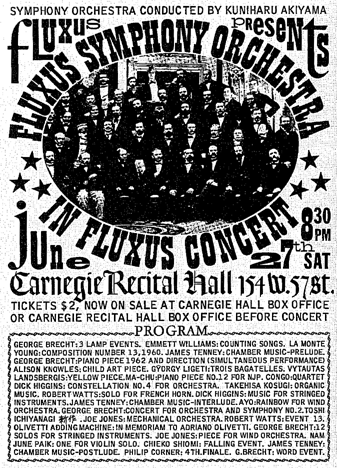
Announcement for a concert by Fluxus Symphony Orchestra
at the Carnegie Recital Hall, New York, 27 June, 1964,
Collection Vytautas Landsbergis
|
PS: Could you tell me about Yellow Piece? What was the score of this “yellow piece” like?
VL: Yellow Piece was a piano piece, played not on the keyboard, but played with the pedals, which are usually yellow. Yellow, like brass, and the bottom of the piano is of course always yellow as well. The piano is black, the bottom is yellow, the strings are yellow. And the performer crawled on the floor to the piano in order to touch the pedals, and then played the pedals, and at the end of the piece, he did what he wanted for some time; slower, more sound or less sound, from the free improvisation he did one thing or another. Of course, the visual perception was also interesting – what was this crazy person doing – and the final point should be a kick at the bottom of the piano. Then, of course, the sound would be very harsh, rough, and all the strings would sound – tutti, a mighty tutti – and my idea was that if we had some special equipment and preparation, there could be a fountain of beer as well.
PS: Of beer?
VL: Yes, yellow! From the piano, it could run through the audience, at the same time as this step and great sound. In my imagination, it was like a joke again: “Jurgis, you are always inventing and sending me various jokes, here’s one joke from me!” When Jurgis sent me a Fluxus newspaper with programmes of festivals, and I saw my name with Yellow Piece, I was terrified that my joke had become reality. So I tried not to make great publicity for myself in Lithuania, to make it known that I was performing at some strange festivals.1 This very unexpected participation in a Fluxus event in the West, is one of those moments to remember after all these years.
PS: And what was this Fluxus installation at the event we were talking about in 1966?
|
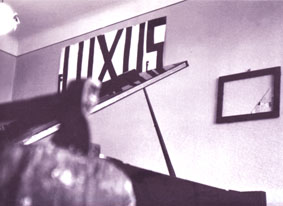
Fluxus concert at Vilnius Pedagogical Institute
photo: Vytautas Landsbergis
|
VL: I asked students to bring various things: a frame for a picture, a big wooden trunk, to make wood for the fireplace, and an axe. And then we painted this trunk red so it would look bloody and took this axe as if it was a place for executing students. They always thought that the professors were killing them, like executors. So it was about student executions, which were now finished: they were now well treated, they could walk away. We used a piano for this performance only because everybody would expect somebody to play seriously, and I used the picture frame to make a picture with an accidental piece of paper from a newspaper in the corner of it. That was as another puzzle. “What can it all mean? OK, it’s up to you.” I could reflect upon it myself, what it possibly could mean for myself, but if somebody else would reflect upon it or interpret this puzzle, or if nobody would be interested in it at all – that was not my business. And here, there was also a slogan. Because the word Fluxus was not known, I made it into LUXUS with a very small f. There was one very big slogan on the wall, as was usual in communist times – very important slogans. It was a very stupid sentence from one of the student poems in a local newspaper. I took it as a quotation with his name as if it was Stalin or Lenin: “Things and people are moving like the pistons of an engine.”
PS: And then you also took an active part in the spatial poems when Mieko Shiomi invited you?
VL: Yes, she was very consistent at sending letters, suggesting that people sent back some ideas, so that there were some letters in response, and some more ideas. I did not know how she used it, but later I saw somewhere that my response had not been in vain. As Fluxus is a young idea – and immortal: immortal youth! – it is a pleasure to remember being young.
1 The Yellow Piece by Vytautas Landsbergis was announced on a poster (the centerfield of VTRE 4) to be played by the Fluxus Symphony Orchestra at the Carnegie Recital Hall, New York, on June 27th in 1964. However, on the programme cards for the evening, designed by Robert Watts, Landsbergis’ name and the Yellow Piece are missing – so it is not evident whether the piece was actually performed.
The interview was earlier published in the catalogue to the exhibition Fluxus East: Fluxus Networks in Central Eastern Europe, 2007-2008.
World New Music Magazine Nr. 18







